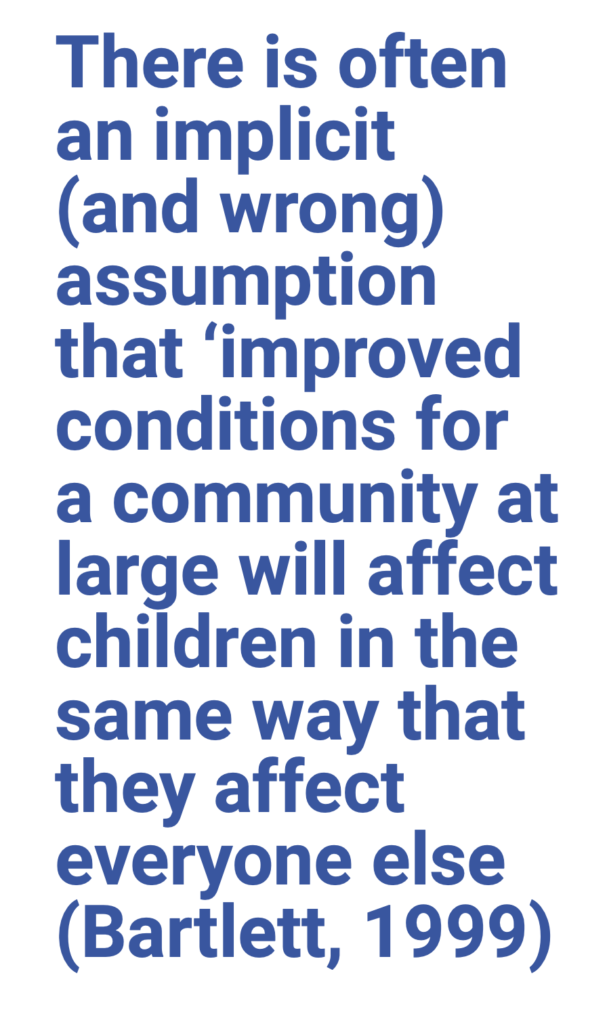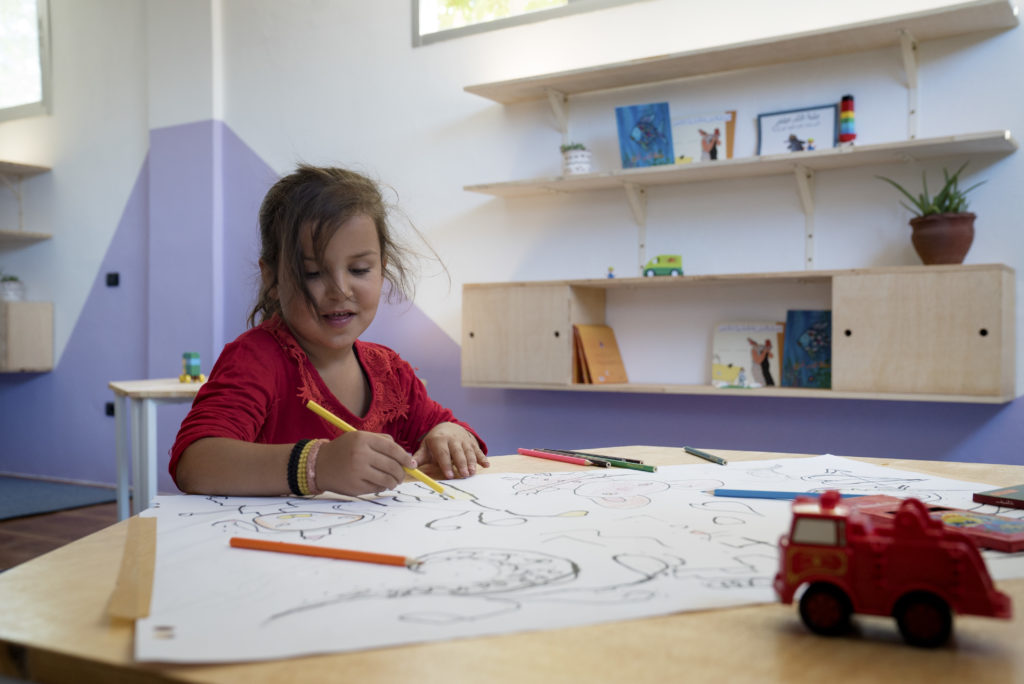By outlining the link between child wellbeing and the built environment, this section makes a case for child responsive built interventions. Research has shown a correlation between the built environment and children’s wellbeing: the ‘neighbourhood built environment may be important for reducing mental health difficulties and increasing mental health competence in young children’ (Alderton et al., 2019). Neighbourhood design can foster a sense of safety, positive identity and belonging, reduce tensions and provide protection from traumatic symptoms in children (Akkesson and Denov, 2017, p. 140).
Save the Children indicates that spaces that encourage children to play, express themselves, and socialise may be key in reducing stress, improving resilience and positive development (Bartlett and Iltus, 2007). Access to nature and public open spaces are important for mental health competence and its association with lower mental health difficulties (Alderton et al., 2019).
The built environment contributes to children’s ability to learn (Bartlett and Iltus, 2007). For a young child’s brain to develop well, it must be stimulated by ‘colours, textures, shapes, by the chance to watch, touch, imitate, experiment, and explore… A safe, stimulating environment is fundamental in ensuring that children have the play opportunities that they need, so that every day is a chance to learn’ (ibid., p. 6).


Furthermore, there appears to be a relationship between the built environment and children’s sense of self-worth (Chawla, 2001). For instance, children see deprived elements of the built environment as a humiliating reflection of their own value as people (ibid.). There is solid evidence
of the benefits of physical activity and play for children’s cognitive and psychosocial development and wellbeing. Data from the fields of neuro- psychology and psycho-pharmacology reveal that clear changes in the brain happen as a result of play, and that both social behaviour and the capacity for learning are affected (Hughes, 1999).
The link between poor living environments and poor child development is particularly evident in contexts of crisis, where children often live in long term encampments that lack educational and play facilities. Informal settlements are characterised by the poor structural quality of housing and lack of basic services. Poor households often construct their homes from recycled building materials, which are often flimsy (Elorduy, 2017), and such dwellings can lack natural light, ventilation, thermal properties, privacy and have inadequate indoor and outdoor spaces.
Some studies suggest that the sensitivity of young children to poor living environments can cause irreversible physical and mental damage (Gordon et al., 2003). Therefore, in contexts where children are deprived of opportunities for social learning, a supportive and safe built environment can make a substantial difference to children’s quality of life. Moreover, where the presence of children in the public realm is encouraged, the perception of safety tends to increase, attracting people and enhancing opportunities for social interaction (Bartlett, 1999).

However, built environment practitioners frequently fail to consider the possible impact that the spaces they design and build have on child wellbeing. There is often an implicit (and wrong) assumption that ‘improved conditions for a community at large will affect children in the same way that they affect everyone else’ (Bartlett, 1999).
Acknowledging the important role of the built environment in child wellbeing has led several actors to develop child responsive built interventions. Within this set of interventions, this handbook proposes co-design with children as a useful approach and next section will introduce some of its benefits. The two concepts below, developed by UNICEF, further promote the idea of improving child wellbeing through better planned and designed physical environments for children in urban settings and in emergency contexts. These are child friendly cities and child friendly spaces.
The UNICEF Child Friendly Cities Initiative (CFCI) promotes that children and adolescents, including the most excluded, benefit from the development and implementation of inclusive, non-discriminatory, child-responsive policies at the local level. Through meaningful, inclusive and regular child participation in local decision-making processes in urban settings, children and adolescents will have access to quality, essential social services, will live in a safe, secure and clean environment, and will have opportunities to enjoy family life, play and leisure.
Inspirational examples are available on the platform of UNICEF’s Child Friendly Cities Initiative.
Child Friendly Spaces (CFSs) are a type of social infrastructure for
children used by humanitarian agencies to increase children’s access to safe environments and promote their psychosocial wellbeing. CFSs try to provide a safe place where children can come together to play, relax, express themselves, feel supported and learn skills to deal with the challenges they face (Severijnen and Steinbock, 2018). In emergency situations, such as conflicts and natural disasters, CFSs have become a widespread response to the challenges that children face.
CFSs have a positive impact on children affected by displacement, but they are not always set up through participatory processes that engage with children. Thus, they miss out on the wellbeing benefits of engaging children in co-design processes.
A more detailed discussion on child wellbeing and the built environment can be found in the DeCID Thematic Brief: Child Development and Participation in Urban Displacement.



